In the wake of the Aug. 22 Disruption to the Securities Information Processor run by Nasdaq and the subsequent order from Securities and Exchange Commission Chairwoman Mary Jo White to the nation’s exchanges that they formulate a plan to strengthen the integrity of the exchange network, Nasdaq OMX CEO and president Bob Greifeld has been addressing industry and shareholder concerns about the problem. This fall the exchange head discussed the issue with analysts on a quarterly earnings call. Two weeks prior, he addressed attendees at the Investment Company Institute’s annual market structure conference. Traders excerpts some of his comments on what changes are being made inside Nasdaq and the changes the capital markets must address.
ON MAKING IMPROVEMENTS TO THE SECURITIES INFORMATION PROCESSOR.
BOB GREIFELD: In the technology business, there will always be latent bugs in the code. It’s our job to basically isolate them and make sure that when they happen, they don’t have an impact on the world. So coming out of Aug. 22, there’s obviously a lot of things we have to do with respect to the SIP and how it works in the environment. I think that represents, in certain ways, an opportunity for our technology business to put forward a state-of-the-art proposal for the SIP committee to get it up to world standards. We intend to pursue that. I think under Mary Jo’s leadership, the industry itself is starting to grapple with what we have to do to live in this interconnected world.

ON THE SEC CHAIRWOMAN’S SEPT. 12 REQUEST FOR A PLAN OF ACTION FROM THE EXCHANGES.
GREIFELD: The 60-day clock is ticking. I think it comes up the 12th of November. And we intend to be ahead of the curve in terms of how we respond to that. So we’re excited about that.
ON A NEW TESTING REGIME.
GREIFELD: It’s our strong feeling the industry has to evolve to some type of centralized testing regime. And we certainly referred to the telecom industry and others, where you have the equivalent of an underwriters’ laboratory that represents your ability to do nonsequential testing that assures the safety and sanctity of the entire network.
ON THE COSTS AND BENEFITS OF OPERATING THE SIP.
GREIFELD: There’s a revenue stream, but there’s not a profit stream. We’ve operated the SIP kind of by default, based upon the vestige of our monopoly position pre-Reg NMS. And when you think about it, we’ve operated it for-as it turns out-infinite risk with zero financial return. So we have to have a proposal for the SIP that makes sense, and that represents a decent margin for us. Not excessive, but more importantly, we have to put forward a proposal where the SIP technology can be brought forward into the 2015-type best-of-breed practices. And it deserves that. At end of the day, it’s not our decision whether that’s done. It’s the decision of the SIP committee. But clearly, we would not have too much interest in continuing in the current relationship where there’s no … the way it’s operated, the technology is just fraught with too much peril.
ON THE POSSIBILITY THAT NASDAQ COULD BE FORCED TO UPGRADE THE SIP WITHOUT NECESSARILY RECEIVING ANY COMPENSATION FOR IT.
GREIFELD: Will the SEC force the committee to upgrade the SIP? And then, the SIP has to choose a vendor to do that? That’s a possibility. I don’t want to speak for the SEC or other market participants, but I think the community, as a whole, recognizes that the SIP is a critical piece of the infrastructure and deserves to have state-of-the-art technology behind it. State-of-the-art support contracts. And state-of-the-art service-level agreements between the SIP and the vendor associated with it. So I don’t think there’s going to be too much commotion associated with this.
ON NASDAQ’S THINKING IN THE AFTERMATH OF THE FACEBOOK DEBACLE.
GREIFELD: Coming out of the Facebook situation, we had time for reflection. It became readily apparent that we were too dominated by an engineering culture and the product management function had atrophied under the dominance of the technical people in the organization. We had a number of different pieces of our technology operation which were engineered for engineers entertaining each other in order to demonstrate what they could accomplish. So we had to come out of that and rebalance the organization.
ON SINGLE POINTS OF FAILURE.
GREIFELD: What we are focused on now is how the industry is interconnected. What the points of interconnection are. What are considered single points of failure. And how do we make sure that that doesn’t come up to bite us. Under Mary Jo White’s direction, I think we have a pretty firm grasp of what we have to do in the short term.
ON THE NEED FOR “NEGATIVE” TESTING.
GREIFELD: In terms of how we make this fragmented world work together, one of the things we are focused on is the lack of sophistication in the negative-case scenario. The industry has improved with respect to “positive” cases. But when you’re trying to break the industry infrastructure … we have to get better at that.
ON ESTABLISHING AN INDUSTRY BODY TO DO THE TESTING.
GREIFELD: We certainly think that the end state for the industry-what we’re calling internally SBI 2.0-is some form of certification from a centralized body. We’re spending time with the telco industry to see how they’ve done it and how they work. But we’re going to have to do that. You don’t even have to have a nonsequential, nonlinear ability for the industry to test. You need to be able to test on a seven-day cycle.
ON THE INTERVENTION OF THE SEC IN THE WAKE OF THE AUGUST SIP MALFUNCTION.
GREIFELD: I think what we’re doing with Mary Jo is great. It’s going to be dramatically helpful. And I think the industry will look more like the telephone industry than it does today.
(c) 2014 Traders Magazine and SourceMedia, Inc. All Rights Reserved.
http://www.tradersmagazine.com http://www.sourcemedia.com/






